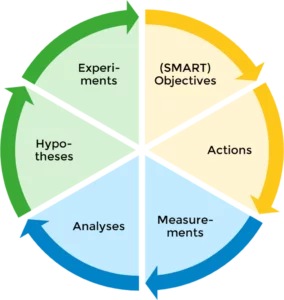Summery and Context
Our first article has guided you the way to a value-added data strategy by setting smart goals and using the right analytics. In this second article in the six-part series of articles on data strategy design, we look at the Customer Touchpoints Canvas.
The Customer Touchpoints Canvas is available as open source on our website and is part of a complete designkit. The strategy consultancy Datentreiber, founded by Martin Szugat, uses this canvas to develop data strategies for its customers. Furthermore, it forms the basis for the Datengipfel seminars on data strategy design offered by Datentreiber.
This article shows how the Customer Touchpoints Canvas helps you to systematically design the customer journey. It can be used to find relevant metrics and the right tracking points as well as to identify sources for necessary data. Thus, you create the foundation for truly data-driven actions in marketing, sales and various other areas.
Note: The article deals with the goals and possibilities of the presented canvas. However, it is not a step-by-step guide. On our website you can find a tutorial that guides you in more detail through the work with the Customer Touchpoints canvas. In addition, the data strategy beginners seminar offers the chance to learn more about working with this canvas or the data strategy designkit. At the training you also have the opportunity to apply the method to your own business.
How to Transform New Customers into Loyal Customers?
The Customer Touchpoints Canvas is based on the AARRR model of 500 HATS. It divides the customer journey into five phases.

In each phase you pursue different goals. Accordingly, different questions must be answered and measurement points and KPIs must be defined:
- Acquisition: Potential customers may not even know your company yet. Also, there may not yet be a need for your offerings on the customer side. You want to attract attention and arouse interest. This can be done by offline (e.g. trade fairs) as well as with online measures (e.g. Google Ads).
- Activation: A customer who has recently been acquired or was recommended your company shows interest in your offer. It can also be an existing customer who has been reactivated through a customer loyalty initiative. You want to convince the customer of your products or services. Likewise, the activation can take place offline (e.g. catalogue dispatch) or online (e.g. corresponding product pages on your website).
- Retention: The cost of turning an already acquired customer into a paying customer is usually much lower than the cost of acquiring a new customer. You want to extend the customer relationship and keep the customer active? You can for example send out newsletters to inform your already registered customers about new offers.
- Referral: In addition to paying customers, leads or brand ambassadors (e.g. social media influencers) can also help to reduce customer acquisition costs through recommendations. You want to give customers and prospects a reason to recommend you to others.
- Revenue: You want all activities to contribute directly or indirectly to your company’s revenue.
The Customer Touchpoints Canvas thus enables you to map the customer journey along the sketched funnel.
After displaying the customer journey using the canvas: How easy was it for you to describe the customers’ path? Did you discover inconsistencies? Are important parts missing? This explicit mapping is the first step towards the systemic development of measures for data-driven improvements.
What Goals Do You Set Yourself and How Do You Measure Them?
Do you remember our last article in this series? We have explained what SMART objectives are and why they need to be embedded in a control loop to actually achieve the desired results.

From each of the above-mentioned, higher-level objectives in the phase of the customer journey, you must derive SMART objectives: specific, measurable, attractive, realistic and time-bound.
You certainly do not want to end up like John Wanamaker, to whom the following quotation is attributed:
The Customer Touchpoints Canvas is the ideal tool to run through exactly such questions. To initially identify weak points, you can map the current status on the canvas. Alternatively, you can start with the target state you have already defined in advance and use the canvas to derive the necessary measures to get there.
Regardless of which path you take, experience from working with the data strategy designkit shows that you almost certainly gain one of the following insights:
- There are gaps in your customer path: The customer journey is incomplete. Customers often by chance find their way from your sometimes expensively paid acquisition measures to your services.
- You have not defined goals and KPIs for the phases: Budgets are sometimes distributed to (marketing & sales) measures in the phases without any real insight of their efficiency.
- You lack data to measure SMART objectives: There are no systematic measurement points along the customer path. The necessary data for measuring the success of activities is not collected.
By visualizing the problems with the help of the Customer Touchpoints canvas you have achieved what Martin Szugat repeatedly points out during the Datengipfel seminars. With this basis you can begin to elaborate the target state.
Conclusion and Outlook
This second article in the series presented the Customer Touchpoints canvas as a tool for measuring the customer’s journey. After the first article of our series presented the context of a successful data strategy, this article explains how to move from the overall objectives of a phase to SMART objectives with measurable KPIs starting with the representation of the customer journey. In the next article, we will show you how to use the Analytics Maturity model to determine where you stand and define the next best step on the path to your data strategy.
After this, the third article: Your First Step Towards a Data-driven Company (3/6) will show you how to use the Analytics Maturity canvas level to determine the location and define the next-best step on the way to your data strategy.
The Data Strategy canvas, covered in the fourth article: With a Data Strategy Against Your Thirst for Information (4/6), helps you to design and concretize the elements of your data strategy.
The Data Landscape canvas is the subject of the fifth article: Explore Your Data Landscape (5/6) . This helps you to clarify the technical requirements for your data strategy.
The sixth and final article: Hit the Sweet Spot With Your Data Strategy (6/6) in the series of articles deals with a complete overview of the Data Strategy Design.
Note: Author of this article, which was originally published in German language and in full length on the Datentreiber blog, is Martin Raffeiner, Managing Director at datenbotschafter consulting.
Did we awake your interest in the development of data strategies? Then take a look at our Datengipfel Seminars Data Strategy & Culture for beginners and Data Design Thinking for advanced participants. Or contact us if you have any further questions.

